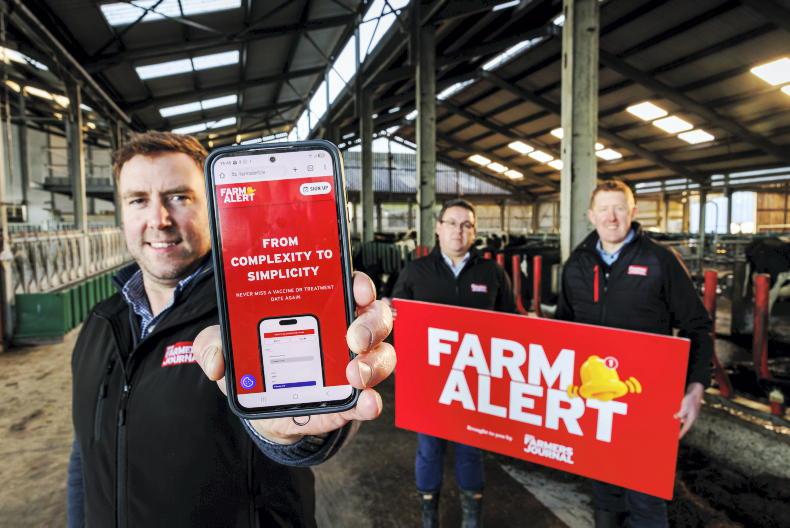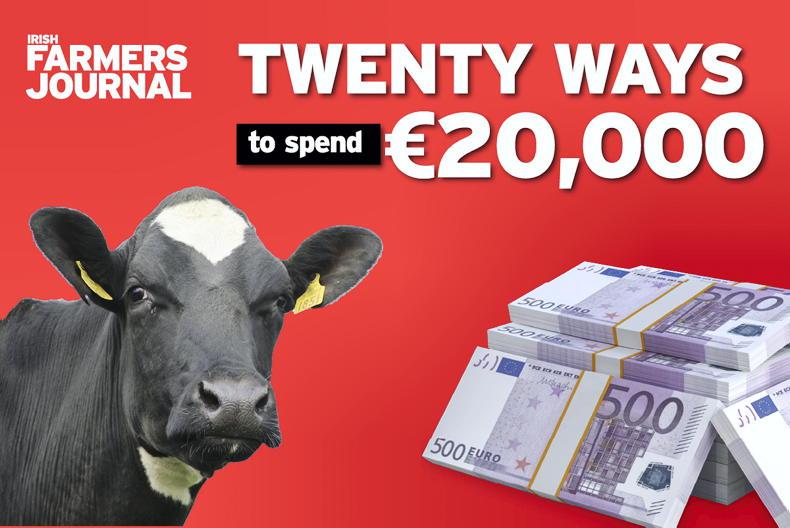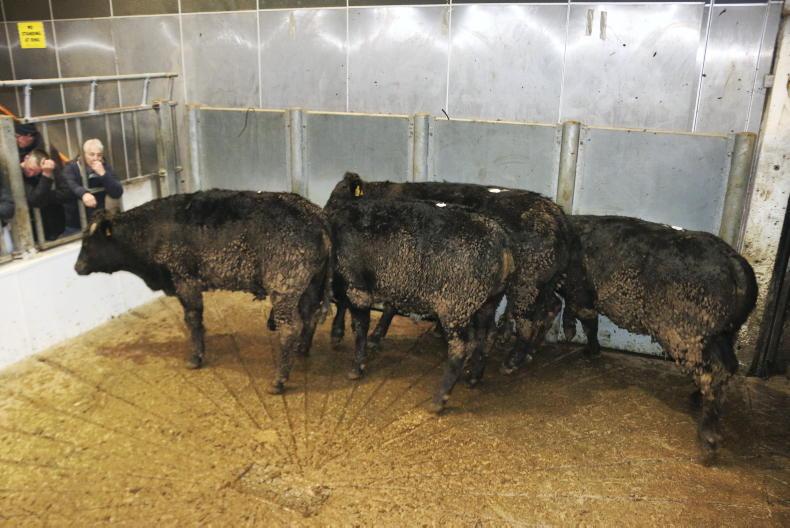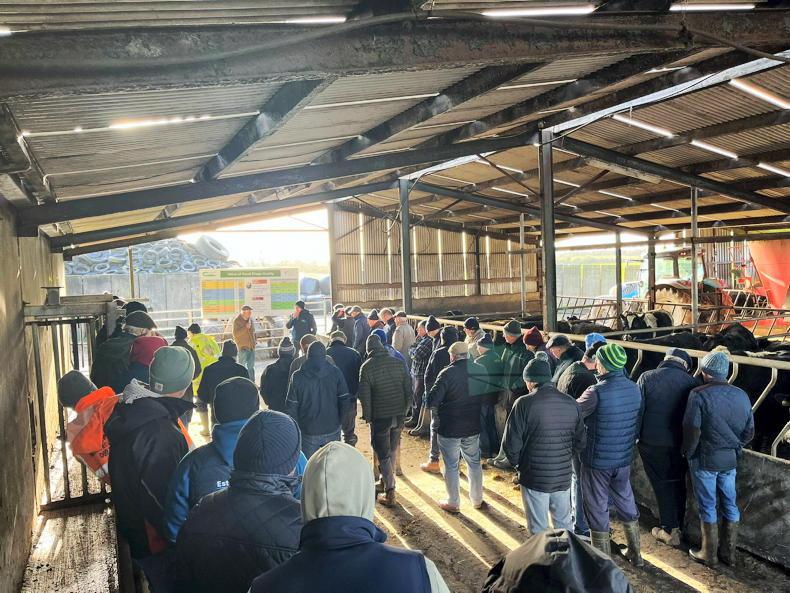Coming off the back of a difficult 2023 for farming, farmers have drawn a clean slate and have begun preparing for the calving season. Now is a good time for farmers to refocus their minds on some of the key management principles to successfully rear good quality calves this spring.
John and Marie Hurley milk 130 cows supplying Drinagh Co-op. The farm is situated on top of a hill, exposed to wind the design of the calf shed was very important.
There is a sliding door in the centre of the shed with pens to the left and right. The centre passage is big enough for a tractor to clean out pens. Calves are grouped in pens of 10, all fed with a 12-point nipple bar feeder.
There are six pens in the calf shed, adjacent to this shed is the calving house with single cow calving boxes divided by gates. When calving slows down and calf numbers are at peak, these calving boxes can be converted to calf pens.
There are no single calf pens, all calves are grouped by age. All calves are fed whole milk meaning there is no milk replacer fed on farm.
Maximising immunity for the calf is half the battle and gives the calf the best chance of survival. Two major factors to this are hygiene and colostrum.
Most farmers will be excellent at this at the beginning of the season, but sometimes corners are cut in March when workload increases.
Cleaning out and regular bedding of calf houses along with good ventilation is the simplest but most effective way of keeping hygiene standards high, while it’s back to basics with the 1,2,3 colostrum rule.
Using colostrum for the first feed, in the first two hours of life, feeding three litres is essential. Quality of colostrum is important, with heifers and stressed cows likely to have lower quality. Colostrum can be simply tested with a brix refractometer, and a reading of 22% or above indicates acceptable levels of antibodies.
At a recent AHI/Teagasc Calfcare event, vet Willie Buckley spoke about the importance of preventing Johne’s transmission by not pooling colostrum. He said it is most important not to pool dairy heifers’ milk but, in some cases, dairy beef colostrum can be pooled, as they will be slaughtered before the effects of Johnes.
It is recommended to keep calves on transition milk for four to five days if changing to milk replacer. After this there is no health benefit to feeding whole milk versus milk replacer.
Calves should drink 15% of their bodyweight (6l for 40kg calf) daily, and once-a-day feeding should not be considered until after four weeks of age.
Also speaking at the calf care event, was David White, Volac. White said that when feeding milk replacer, it should contain 750 grams of milk powder in six litres and be divided into two equal feeds.
Of the 750 grams fed, approximately half is required for maintenance of the calf and the remainder is available for growth.
Good quality milk replacer is vital to optimise calf health and growth. When selecting what milk replacer to use, there are some key specifications that should be considered.
Protein content between 23-26%.Fat content between 16-20%.Ash content no more than 7-8%.Maximum fibre content of 0.1%.Water
The importance of fresh water for young calves is underestimated on many farms. Calves should be offered fresh water from the first days of birth. Water is essential for hydration, but it also plays a vital role in development of the rumen.
Development of the rumen is dependant on the bacterial fermentation of starter concentrate. For fermentation to occur, the bacteria need water.
Butyric acid formed as a result of the fermentation of concentrates develop the rumen as they grow and thicken papillae which allows maximum absorption. Regardless of the concentration of water in milk replacer, calves should have access to fresh drinking water.
Calves require 4-5 litres of water for every 1kg concentrates eaten. Calves still drinking milk at 5-6 weeks old have the capacity and requirement to drink 5-6 litres of water.
Studies have shown that water offered to calves in the first four weeks eat between 31-60% more concentrates and have a 38% higher weight gain.
Breeding
Producing calves for pasture-based beef production from the dairy herd is the most profitable outlet for calves from the dairy herd. To maximise this, beef farmers need a healthy calf with good beef genetic merit.
Traditionally, when a dairy farmer picked what beef bull to use, calving difficulty was the main trait which satisfied farmers, along with a short gestation period.
While this may have been the correct decision to make from a dairy point of view, beef traits have paid the cost. The dairy beef index (DBI) has provided indexes for dairy farmers to have benefits to both dairy and beef farmers.
In 2023, for the first time in over 30 years, the number of calves born to the dairy herd was more than twice that of calves born to the suckler herd, with approximately 68% of all calves born coming from the dairy herd amounting to 1.61m. With this in mind, producing quality beef calves is important now more than ever.
The DBI is a tool for dairy farmers to improve quality of dairy beef calves without compromising on the essential characteristics such as easy calving and short gestation length. The three main sub-indexes in DBI are, calving, beef and carbon indexes.
How to breed High CBV calves?
When selecting a bull in the DBI, carcase conformation is scored on a 15-point scale, where 1 is P- and 15 is E+. If Bull A has a predicted transmitting ability (PTA) of -1.5 and Bull B has a PTA of +1.0, we expect the progeny from Bull B will be, on average, 2.5 conformation grades higher than those from Bull A.
Easier calving bulls are more desirable; hence, lower PTA values are preferred.
Where a bull has a PTA for calving difficulty of 8% on dairy heifers, roughly two out of every 25 calves born to dairy heifers are expected to require considerable assistance, due to a heavier birth size.
In essence, farmers should be looking for lower PTA values for the dairy traits such as calving difficulty and gestation length, but select for higher PTA values for beef merits such as carcase weight and quality. A bull with a high beef value DBI will generate a higher commercial beef value (CBV) for the beef calf.
Calf value in 2023
Creating and maintaining markets for dairy beef calves from dairy farms has become a progressive challenge in recent years, with the threat of losing live export markets being a big worry.
Speaking at the Positive Farmers conference, Teagasc’s Padraig French posed the question to the audience asking how many farmers now already have a market for their 2024 calves? One way outlined by French to maintain a strong market for these calves is to produce a high value beef calf to the beef farmer
Data was taken from 72,375 calf sales in Cork marts in spring 2023 to determine what factors influenced calf price. Moorepark researcher Alan Twomey conducted the study, looking at factors such as age, weight, breed and timing of sale.
Peak price for calves was seen in late January and declined to the lowest price in late March, which correlated in line with calf supply. Age of the calf didn’t have much impact on calf sales, while the weight of the calf at sale had a significant impact on price.
The data showed that for every kilo more at sale, the calf demanded €5 more selling price.
Breed also had a significant impact. Breeds such as Belgian Blue and Charolais demanded top price at €210, where dairy breeds such as JE and FR averaged at €50 for 55kg calves.
Three pieces of advice given by Padraig French for 2024 was to focus on the health and feeding of calves, using sexed semen to reduce the number of dairy bulls in the market and focus on carcase weight as well as calving ease when picking beef bulls.
Coming off the back of a difficult 2023 for farming, farmers have drawn a clean slate and have begun preparing for the calving season. Now is a good time for farmers to refocus their minds on some of the key management principles to successfully rear good quality calves this spring.
John and Marie Hurley milk 130 cows supplying Drinagh Co-op. The farm is situated on top of a hill, exposed to wind the design of the calf shed was very important.
There is a sliding door in the centre of the shed with pens to the left and right. The centre passage is big enough for a tractor to clean out pens. Calves are grouped in pens of 10, all fed with a 12-point nipple bar feeder.
There are six pens in the calf shed, adjacent to this shed is the calving house with single cow calving boxes divided by gates. When calving slows down and calf numbers are at peak, these calving boxes can be converted to calf pens.
There are no single calf pens, all calves are grouped by age. All calves are fed whole milk meaning there is no milk replacer fed on farm.
Maximising immunity for the calf is half the battle and gives the calf the best chance of survival. Two major factors to this are hygiene and colostrum.
Most farmers will be excellent at this at the beginning of the season, but sometimes corners are cut in March when workload increases.
Cleaning out and regular bedding of calf houses along with good ventilation is the simplest but most effective way of keeping hygiene standards high, while it’s back to basics with the 1,2,3 colostrum rule.
Using colostrum for the first feed, in the first two hours of life, feeding three litres is essential. Quality of colostrum is important, with heifers and stressed cows likely to have lower quality. Colostrum can be simply tested with a brix refractometer, and a reading of 22% or above indicates acceptable levels of antibodies.
At a recent AHI/Teagasc Calfcare event, vet Willie Buckley spoke about the importance of preventing Johne’s transmission by not pooling colostrum. He said it is most important not to pool dairy heifers’ milk but, in some cases, dairy beef colostrum can be pooled, as they will be slaughtered before the effects of Johnes.
It is recommended to keep calves on transition milk for four to five days if changing to milk replacer. After this there is no health benefit to feeding whole milk versus milk replacer.
Calves should drink 15% of their bodyweight (6l for 40kg calf) daily, and once-a-day feeding should not be considered until after four weeks of age.
Also speaking at the calf care event, was David White, Volac. White said that when feeding milk replacer, it should contain 750 grams of milk powder in six litres and be divided into two equal feeds.
Of the 750 grams fed, approximately half is required for maintenance of the calf and the remainder is available for growth.
Good quality milk replacer is vital to optimise calf health and growth. When selecting what milk replacer to use, there are some key specifications that should be considered.
Protein content between 23-26%.Fat content between 16-20%.Ash content no more than 7-8%.Maximum fibre content of 0.1%.Water
The importance of fresh water for young calves is underestimated on many farms. Calves should be offered fresh water from the first days of birth. Water is essential for hydration, but it also plays a vital role in development of the rumen.
Development of the rumen is dependant on the bacterial fermentation of starter concentrate. For fermentation to occur, the bacteria need water.
Butyric acid formed as a result of the fermentation of concentrates develop the rumen as they grow and thicken papillae which allows maximum absorption. Regardless of the concentration of water in milk replacer, calves should have access to fresh drinking water.
Calves require 4-5 litres of water for every 1kg concentrates eaten. Calves still drinking milk at 5-6 weeks old have the capacity and requirement to drink 5-6 litres of water.
Studies have shown that water offered to calves in the first four weeks eat between 31-60% more concentrates and have a 38% higher weight gain.
Breeding
Producing calves for pasture-based beef production from the dairy herd is the most profitable outlet for calves from the dairy herd. To maximise this, beef farmers need a healthy calf with good beef genetic merit.
Traditionally, when a dairy farmer picked what beef bull to use, calving difficulty was the main trait which satisfied farmers, along with a short gestation period.
While this may have been the correct decision to make from a dairy point of view, beef traits have paid the cost. The dairy beef index (DBI) has provided indexes for dairy farmers to have benefits to both dairy and beef farmers.
In 2023, for the first time in over 30 years, the number of calves born to the dairy herd was more than twice that of calves born to the suckler herd, with approximately 68% of all calves born coming from the dairy herd amounting to 1.61m. With this in mind, producing quality beef calves is important now more than ever.
The DBI is a tool for dairy farmers to improve quality of dairy beef calves without compromising on the essential characteristics such as easy calving and short gestation length. The three main sub-indexes in DBI are, calving, beef and carbon indexes.
How to breed High CBV calves?
When selecting a bull in the DBI, carcase conformation is scored on a 15-point scale, where 1 is P- and 15 is E+. If Bull A has a predicted transmitting ability (PTA) of -1.5 and Bull B has a PTA of +1.0, we expect the progeny from Bull B will be, on average, 2.5 conformation grades higher than those from Bull A.
Easier calving bulls are more desirable; hence, lower PTA values are preferred.
Where a bull has a PTA for calving difficulty of 8% on dairy heifers, roughly two out of every 25 calves born to dairy heifers are expected to require considerable assistance, due to a heavier birth size.
In essence, farmers should be looking for lower PTA values for the dairy traits such as calving difficulty and gestation length, but select for higher PTA values for beef merits such as carcase weight and quality. A bull with a high beef value DBI will generate a higher commercial beef value (CBV) for the beef calf.
Calf value in 2023
Creating and maintaining markets for dairy beef calves from dairy farms has become a progressive challenge in recent years, with the threat of losing live export markets being a big worry.
Speaking at the Positive Farmers conference, Teagasc’s Padraig French posed the question to the audience asking how many farmers now already have a market for their 2024 calves? One way outlined by French to maintain a strong market for these calves is to produce a high value beef calf to the beef farmer
Data was taken from 72,375 calf sales in Cork marts in spring 2023 to determine what factors influenced calf price. Moorepark researcher Alan Twomey conducted the study, looking at factors such as age, weight, breed and timing of sale.
Peak price for calves was seen in late January and declined to the lowest price in late March, which correlated in line with calf supply. Age of the calf didn’t have much impact on calf sales, while the weight of the calf at sale had a significant impact on price.
The data showed that for every kilo more at sale, the calf demanded €5 more selling price.
Breed also had a significant impact. Breeds such as Belgian Blue and Charolais demanded top price at €210, where dairy breeds such as JE and FR averaged at €50 for 55kg calves.
Three pieces of advice given by Padraig French for 2024 was to focus on the health and feeding of calves, using sexed semen to reduce the number of dairy bulls in the market and focus on carcase weight as well as calving ease when picking beef bulls.









SHARING OPTIONS